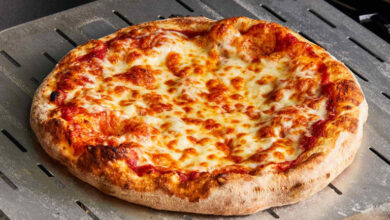The Art of Pairing Food and Beverage: Unleashing Flavor Combinations

Are you ready to embark on a tantalizing journey that will indulge your taste buds like never before? Get ready to unlock the secrets behind the art of pairing food and beverage, where culinary creativity meets liquid perfection. In this blog post, we will delve into the world of flavor combinations, exploring how certain foods can enhance or transform their essence when paired with just the right libation. Brace yourself for an adventure filled with unexpected delights and mouthwatering revelations. Let’s discover together why food and beverage pairings are not just science but also a masterpiece waiting to be unleashed!
Introduction to pairing food and beverage
Pairing food with the right beverage is an essential aspect of creating a well-rounded dining experience. It involves carefully selecting complementary flavors, textures, and aromas that enhance each other, creating a harmonious balance on the palate. A successful pairing can elevate both the food and beverage to new levels, bringing out the best in each.
The concept of pairing food and beverage has been around for centuries. People have always sought out ways to enhance their meals by combining different flavors. In ancient Greece, wine was often paired with specific types of food to balance out their flavors. Similarly, in China, tea is believed to cleanse the palate between dishes and enhance the overall dining experience.
Nowadays, pairing food and beverages has become somewhat of an art form. With a vast variety of ingredients available from all over the world and innovative cooking techniques at our disposal, there are endless possibilities for flavor combinations.
Understanding flavor profiles is crucial when it comes to pairing food and beverage successfully. Every ingredient has its unique taste profile – some are sweet or sour while others may be salty or spicy. Various factors such as cooking methods, seasonings used, or even regional cuisine play a role in determining an ingredient’s flavor profile.
When it comes to choosing which beverage pairs best with a particular dish, similar principles apply. Beverages also have distinct flavor profiles that can be classified as bitter, sweet, acidic or fruity. Matching these characteristics with those found in certain foods can create perfect pairings that bring out the best in both elements.
One of the essential components of successful food and beverage pairings is balance. Each component should complement one another rather than overpowering it. For example, strong red wines tend to pair better with rich meats like beef or lamb because they can stand up against bold flavors without being overshadowed.
Additionally, considering texture when making pairings can have a significant impact on how well two elements complement each other. For instance, a creamy and velvety Chardonnay might pair well with a buttery lobster dish, while an acidic Sauvignon Blanc might cut through the richness of that same dish.
Understanding flavor profiles and how they work together
Understanding flavor profiles is the key to creating successful and harmonious food and beverage pairings. Flavor profiling involves analyzing the unique tastes, aromas, textures, and sensations of each ingredient in a dish or drink. By understanding how these elements interact with one another, we can create more balanced and complementary flavor combinations that elevate the overall dining experience.
The first step in understanding flavor profiles is to identify the five primary tastes: sweet, sour, salty, bitter, and umami. These tastes are perceived by specific taste receptors on our tongues and play a crucial role in our perception of flavors. For example, a dish with a balance of sweet and sour flavors can create a pleasant contrast on the palate.
Next, it’s essential to consider the intensity of each taste within a dish or drink. Some ingredients may have strong flavors that can overpower others if not carefully balanced. For instance, using too much salt can overwhelm other delicate flavors in a dish. On the other hand, a well-measured amount of salt can enhance the overall taste profile by adding depth and complexity.
In addition to taste profiles, aroma also plays an integral part in our perception of flavor. The olfactory senses work closely with our taste buds to create unique flavor experiences. This is why pairing certain foods with aromatic beverages such as wine or tea can amplify their flavors or provide contrast for balance.
Texture is another vital element in understanding flavor profiles. It refers to how foods feel when chewed or sipped – crunchy versus smooth or creamy versus light. Pairing foods with similar textures can create harmony on the palate while contrasting textures add excitement and variety.
Besides individual ingredients’ characteristics, it’s also essential to understand how different cooking methods affect them. Grilling vs frying vs steaming will produce different levels of intensities for each ingredient’s taste profile due to various chemical reactions during cooking.
Experimenting with complementary and contrasting flavors is crucial when trying new food pairings. Combining sweet and salty flavors, or rich and acidic ones, can create a balance that tantalizes the taste buds. However, it’s essential to remember that everyone has different preferences and palates, so what may work for one person may not be as pleasing for another.
Classic flavor combinations and why they work
Classic flavor combinations have stood the test of time for a reason. These tried and true pairings have been enjoyed by food lovers for generations, and their success lies in the harmonious balance they create on the palate.
One of the most beloved classic flavor combinations is salty and sweet. The contrast between these two flavors creates a perfect balance that is both satisfying and addictive. This pairing can be seen in dishes like salted caramel, chocolate covered pretzels, or prosciutto-wrapped melon. The saltiness cuts through the sweetness, creating a depth of flavor that keeps you coming back for more.
Another well-known combination is spicy and sour. While spicy foods can often overwhelm your taste buds with heat, incorporating sour flavors helps to tame it down while adding brightness to the dish. A prime example of this pairing is seen in Asian cuisine, where spicy chili peppers are often balanced with tangy ingredients like vinegar or lime juice.
Savory and umami is another classic combination that has become popularized in recent years thanks to its unique ability to enhance flavors. Umami is known as the fifth taste (alongside sweet, salty, sour, and bitter) and is often described as savory or meaty. It can be found naturally in ingredients like mushrooms, tomatoes, soy sauce, and Parmesan cheese. When paired with other savory ingredients such as bacon or beef broth, umami adds depth and complexity to dishes.
On the other end of the spectrum from savory is fruity and floral combinations. This pairing works so well because many fruits have natural floral notes that complement each other perfectly when combined in a dish or beverage. Fruits like strawberries or peaches often go hand-in-hand with flowers such as lavender or rosewater to create delicate yet bold flavors.
Lastly, it’s impossible to talk about classic flavor combinations without mentioning rich and acidic pairings. Acidic ingredients like citrus fruits or vinegar help cut through heavy and rich dishes, adding a burst of freshness. Think of a squeeze of lemon over a buttery piece of fish or a splash of balsamic vinegar on top of creamy mozzarella cheese.
Tips for creating your own unique pairings
Creating unique and complementary pairings between food and beverages is an art that takes practice and experimentation. Whether you are a seasoned chef or amateur foodie, these tips will help you unleash your creativity and create your own unique flavor combinations.
1. Consider the Flavor Profile: Each food and beverage has its own distinct flavor profile, which is influenced by factors such as ingredients, cooking method, and region of origin. When creating pairings, it is important to carefully consider the flavors present in each element. For example, a spicy dish may go well with a sweet or acidic drink to balance out the heat.
2. Balance is Key: The key to successful pairings lies in achieving balance between the food and beverage. This means finding harmony between flavors, textures, and temperatures. A heavy dish may be balanced by a light drink, while a creamy dessert could be complemented by a crisp refreshing beverage.
3. Don’t Be Afraid to Contrast: While balance is important, contrasting flavors can also result in surprisingly delicious combinations. Think about pairing sweet with salty or sour with spicy for an exciting taste experience.
4. Take Inspiration from Classic Pairings: Classic food and beverage pairings like wine with cheese or beer with pizza have stood the test of time for a reason – they work! Use these classic combinations as inspiration for creating your own unique twists on familiar favorites.
5. Consider Seasonality: Just like fruits and vegetables have different growing seasons, certain foods also have seasonal variations in flavor profiles which can affect their pairing potential with different beverages. For instance, seafood dishes may lend themselves well to lighter drinks during summer months while heartier stews might call for full-bodied wines during colder seasons.
6. Pay Attention to Texture: In addition to flavor matching, it’s crucial to consider textures when creating pairings. For example, avoid pairing two crunchy elements together as this might result in overwhelming contrast instead of harmonious balance.
7. Experiment and Have Fun: The most important tip for creating your own unique pairings is to experiment and have fun with it! Don’t be afraid to push the boundaries and try new combinations. Sometimes the most unexpected pairings can result in the most amazing flavor experiences.
How to pair food and wine/beer/cocktails
Pairing food and beverage is an art that can elevate your dining experience by creating balanced and harmonious flavors. While there are no set rules for pairing, there are some guidelines that can help you in making the most out of your meal.
When it comes to wine pairing, the first thing to consider is the weight and intensity of both the food and wine. A light dish like a salad or seafood would pair well with a light-bodied wine such as Sauvignon Blanc or Pinot Grigio. On the other hand, a heavier dish like steak or pasta would pair better with a full-bodied red wine like Cabernet Sauvignon or Malbec.
It’s also important to take into account the seasonings and sauces used in the dish. If your food has acidic components like citrus, tomatoes, or vinegar-based sauces, it’s best to pair it with an acidic wine such as Chardonnay or Pinot Noir to avoid clashing flavors. Alternatively, if your dish has creamy or buttery elements like cream sauce or cheese, a rich and buttery white wine like Chardonnay would be more suitable.
For beer lovers, matching beer with food can be just as enjoyable as pairing wine. As a general rule of thumb, lighter beers go well with light dishes while darker beers complement richer foods. For example, wheat beers pair nicely with salads and seafood while stouts go well with grilled meats and chocolate desserts.
Cocktail pairing is all about balancing flavors and creating contrast between the drink’s ingredients and those in the dish. A refreshing gin cocktail goes well with spicy dishes while whiskey-based cocktails pair nicely with savory foods like cured meats or aged cheeses.
Another aspect to consider when pairing food and drink is regional cuisine. Certain beverages have long-standing partnerships with traditional dishes from specific regions around the world. For instance, Italian cuisine pairs perfectly with Sangiovese wines while German cuisine goes hand in hand with a crisp pilsner.
The role of texture in pairing food and beverage
When it comes to pairing food and beverage, many people often focus solely on matching flavors. However, the texture of both the food and beverage can play a crucial role in enhancing the overall dining experience. The texture refers to how something feels when you eat or drink it – whether it’s crunchy, creamy, smooth, or chewy. By paying attention to textures, you can create a truly harmonious pairing that will elevate your meal.
One of the key factors to consider when pairing food and beverage based on their texture is contrast. This means selecting items with different textures that complement each other rather than compete for dominance in your mouth. For instance, if you have a dish with a crispy and light texture like a salad, you would not want to pair it with something equally crunchy like chips as they may overpower each other. Instead, opt for something creamy or soft like an avocado dressing or goat cheese. This creates a balance between textures and allows each component to shine.
On the other hand, pairing similar textures can also work well if done thoughtfully. A dish with rich and creamy texture can be complemented by a velvety wine such as Chardonnay or Pinot Noir. The creaminess of both elements enhances each other without being overwhelming.
Another important aspect of texture in food and beverage pairings is mouthfeel – how something feels in your mouth after swallowing it. This includes factors such as thickness, weight, and viscosity of the liquid element being paired with solid foods. For example, thick stews or soups are best served with full-bodied wines or beers that have enough weight and substance to match its heftiness.
Furthermore, considering temperature when pairing food and beverage based on its texture is essential too; hot beverages tend to heighten the perception of creamier dishes while cold drinks bring out more tartness in foods.
Texture also plays a vital role in creating contrast within one dish itself. For example, a juicy and tender steak can be perfectly complemented by a crisp and refreshing beer. Similarly, a dessert with a smooth and creamy texture like cheesecake can be paired with something bubbly and effervescent like champagne to create an interesting contrast.
Pairing for different occasions (casual vs. formal, summer vs. winter)
When it comes to pairing food and beverage, there are many factors to consider. One important aspect is the occasion in which the pairing will take place. A casual gathering with friends may call for a different type of pairing than a formal dinner party. Similarly, the season in which the event takes place can also impact the pairings chosen. In this section, we will explore how to master the art of pairing for different occasions.
Casual vs. Formal:
The key difference between a casual and formal occasion is the level of formality and ambiance. For a casual gathering, such as a backyard BBQ or game night with friends, you want your pairings to be fun and easy-going. Opt for simple but delicious combinations that won’t require too much effort on your part.
For example, a classic burger and beer combination is perfect for a casual get-together. The rich flavors of the burger complemented by an ice-cold beer create a harmonious balance that appeals to everyone’s taste buds.
On the other hand, if you’re hosting a formal dinner party, you’ll want to elevate your pairings accordingly. This means putting more thought into creating complex flavor profiles that impress your guests while still being cohesive with each other. Pairing seafood dishes with dry white wine or steak with full-bodied red wine are great options for a sophisticated evening meal.
Summer vs Winter:
Another factor that plays into selecting food and beverage pairings is seasonal ingredients and weather conditions. During summer months when fresh produce is abundant and temperatures are high, light refreshing pairings are ideal.
Think crisp salads paired with chilled rosé or grilled fish paired with sparkling water infused with fruit slices; these combinations perfectly capture summer’s essence.
In contrast, colder winter months call for richer, heartier pairings that warm you up from within. Indulge in comforting meals like beef stew matched perfectly with bold red wines or hot cocoa spiked with whiskey for cozy evenings by the fireplace.
When it comes to sweet treats, don’t forget about seasonal flavors. For summer, try pairing a fruity sorbet with a refreshing cocktail, while for winter, indulge in a decadent chocolate dessert accompanied by a rich port or sherry.
Common mistakes to avoid in food and beverage pairing
When it comes to pairing food and beverages, there are certain mistakes that can easily be made if you’re not careful. These mistakes can lead to a disappointing dining experience, as the flavors may clash or overpower each other.
One common mistake is pairing overly sweet foods with sweet beverages. While this may seem like a safe choice, it can actually be overwhelming for your taste buds. Instead of balancing each other out, the sweetness of both the food and drink can become cloying and unpleasant. This is especially true when it comes to desserts – pair a rich chocolate cake with a glass of milk or bitter coffee instead of sugary soda.
Another mistake to avoid is choosing drinks with high alcohol content to go with spicy foods. Many people think that a cold beer or cocktail will help cool down their palate after eating something spicy, but in reality, the high alcohol content only intensifies the heat sensation. Opt for low-alcohol options such as light beers or non-alcoholic beverages like iced tea or lemonade.
Similarly, try to avoid pairing acidic dishes with acidic drinks. For example, serving tomatoes in a salad or pasta sauce alongside citrus-based cocktails can result in an unpleasant tartness overload on your tongue. Instead, balance out acidic foods with drinks that have sweeter notes like a fruity wine or even just water.
A crucial mistake many make when pairing food and wine is basing it solely on color rather than flavor profiles. Just because red wine usually goes well with red meat doesn’t mean every red meat dish will pair well with any red wine. Instead of focusing on color alone, pay attention to the flavor notes of both your dish and beverage before deciding on a pairing.
Don’t fall into the trap of sticking to what you know works every time. While there’s nothing wrong with having favorite pairings that never disappoint you, don’t be afraid to experiment and try new combinations as well! You never know, you might discover an unexpected flavor combination that becomes your new go-to.
Conclusion
As we have explored, pairing food and beverage is truly an art form that can elevate any dining experience. Whether it’s a rich red wine with a juicy steak or a crisp white wine with delicate seafood, the right combination can create a perfect harmony of flavors. By understanding some basic principles and experimenting with different pairings, you too can unleash your inner culinary artist and create unforgettable flavor combinations for yourself and others to enjoy. Cheers to discovering the endless possibilities of pairing food and beverage!





